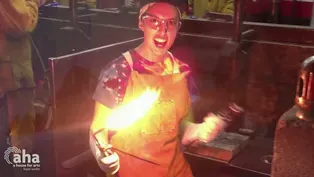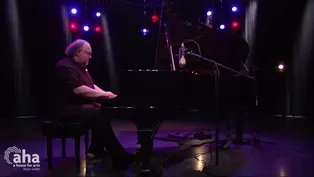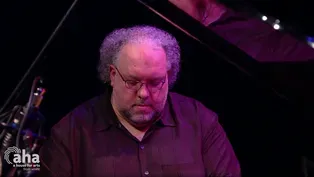
Reinventing Schenectady: Art Renaissance with Gallery 5
Clip: Season 8 Episode 30 | 10m 21sVideo has Closed Captions
Oscar Alberto Bogran shares his journey of artistic self-expression in Schenectady.
Join multidisciplinary artist Oscar Alberto Bogran as he shares his journey of artistic self-expression in Schenectady. From murals to performance art, witness the powerful impact of his work in rejuvenating the city's art scene. Discover the story behind Gallery 5, a collective dedicated to showcasing high-end fine art and fostering a vibrant creative community.
Problems with Closed Captions? Closed Captioning Feedback
Problems with Closed Captions? Closed Captioning Feedback
AHA! A House for Arts is a local public television program presented by WMHT
Support provided by the New York State Council on the Arts (NYSCA), M&T Bank, the Leo Cox Beach Philanthropic Foundation, and is also provided by contributors to the WMHT Venture...

Reinventing Schenectady: Art Renaissance with Gallery 5
Clip: Season 8 Episode 30 | 10m 21sVideo has Closed Captions
Join multidisciplinary artist Oscar Alberto Bogran as he shares his journey of artistic self-expression in Schenectady. From murals to performance art, witness the powerful impact of his work in rejuvenating the city's art scene. Discover the story behind Gallery 5, a collective dedicated to showcasing high-end fine art and fostering a vibrant creative community.
Problems with Closed Captions? Closed Captioning Feedback
How to Watch AHA! A House for Arts
AHA! A House for Arts is available to stream on pbs.org and the free PBS App, available on iPhone, Apple TV, Android TV, Android smartphones, Amazon Fire TV, Amazon Fire Tablet, Roku, Samsung Smart TV, and Vizio.
Providing Support for PBS.org
Learn Moreabout PBS online sponsorshiplike why do you brand yourself as an artist, like how do you see yourself as an artist, who do you perceive yourself to be?
- I guess, I mean, branding kind of makes me uncomfortable.
Like to be labeled or branded just really doesn't sit well with me, I guess.
So I consider myself like a multidisciplinary and I'm a huge fan of like conceptual art because of that, because there's really no box, you know, there's no like, 'cause, you know, if you're a painter, you have to paint.
If you're a sculptor, you sculpt, it's like there's always limitations.
And I think as an artist, for me personally, it kind of like rubs me the wrong way to be labeled.
So if people ask me and I just say I'm multidisciplinary, so I dabble in a lot of different things.
- Well, what are some of those things?
And I understand that it is hard to put an artist in a box, right, 'cause we can like spread throughout so many things, it's so fluid, it's so accessible.
- Well, with me personally, painting has always been like something that I grew up doing, right?
Drawing, painting, a sculptor also, like especially with wood and metal, pretty much anything that I can relay a message with.
It doesn't necessarily have to be traditional media.
It could be my body, you know, like performance art.
I've done some performance art pieces in Boston.
One in particular that I really like, resonates with me is the Immigrant Does Not Equal Criminal project I did in Boston where I welded a cage and I sat in that cage for a whole day in different locations in Boston.
That was, you know, an example of nontraditional medium, you know, that I love, and I feel like it just, it goes against the grain, you know?
And it rubs people the wrong way, and then some people are just like, whoa, what is this, you know?
I got a lot of weird looks, you know, especially like, I was in the Boston Common and there was like a field trip happening at the same time.
So here's this Latin guy in this little cage and all these little kids are like trying to like figure out what's going on.
And you see the teachers like, get away from the weirdo, guys.
- Oh my God.
- You know, so it was so, it's good, like I love that, right, I love to tell stories and I think that there shouldn't be limitations on how to do that.
- So you like the reaction piece to it too, huh?
- Yeah, yeah, it's just like, yeah, if it doesn't leave an impression, then like, did you really do it?
- Yeah, like a tree falls in woods- - Does it really exist?
- Yeah.
I know you're in graffiti and things a little bit too, right?
- Yeah, I grew up, well, yeah, so when we first moved from Honduras, that's where I'm from, I was about seven years old, and we moved to Brooklyn, and the first thing I saw was graffiti art.
Like the trains covered, like, this is like early 80s.
So, you know, hip-hop was forming, like this new like way of thinking was existing that I never knew about.
And when I was exposed to it, I was like, you know, like seeing a cathedral for the first time, it was like, oh, like this godly presence.
And you see these graffiti artists hanging off bridges with belts, you know, and like, I wanna be like that.
Like they were like my superheroes, like they'd be in the sewers, they'd be like in the middle of the night in the abandoned buildings and it, yeah, that really, like I really, it drew me in, you know, it sucked me right in.
So hip-hop, graffiti, you know, I started writing too, like, you know, rapping, doing battle raps- - Everything.
- Everything, like, 'cause I always wanted, like I never stopped learning, I like crave to learn new things, it's just like something that's embedded in me.
I think that's why I decided to go into higher ed, you know, 'cause just learning has always been something I love.
- Yeah, something attractive.
- Yeah.
- So how has that journey, from starting from Brooklyn, you know, did that influence you, you already said the graffiti's influenced you, has anything else from your time and your past influenced who you are?
- I guess just going through a lot of downs, you know, hitting rock bottom, like being homeless at times.
Not having a lot of support as far as, you know, my family is very traditional.
You know, we're an immigrant family.
I remember my father constantly like telling me, "You're not gonna be an artist.
That's not a real job.
Like we basically risked our lives to get to this country, you're not gonna throw it away," you know, and I was just like, okay.
But deep down inside, I'm like, I'm gonna be an artist, like I have to.
So I think the struggle is what made me who I am and going through that struggle, and that's why like I think I'm good with the education piece too, like I see young artists coming up.
And the first thing I hear is like, "It's so hard, it's so hard."
Embrace that.
It's gonna make you who you are.
Like these struggles, this hurt, use that, right, it's like that's our superpower.
We're hypersensitive beings as artists, and using that is what makes the best art, I think.
- Yeah, and how do you use that?
- So yeah, I try to talk about my struggles and my pains through my art.
Whether it's through the paintings I do, the performances, the sculptures, it talks about me, personal.
Like the murals I've done are very personal, they have people, they show people that are personally involved in my life, that had effect in my life.
So I'm just using everything I can possibly feel and try to show people what that feels like.
- Yeah, do you think that's the theme of most of your work reflects on your, like your history, your feelings, your emotions?
- Yeah, definitely, 'cause I feel like that's, it's my outlet, it's my therapy.
Like I need to express a lot of things.
And a lot of times, we can't, right, because it's very personal.
It makes people uncomfortable, nobody wants to hear about your personal stuff.
So I just, let's put it on a wall instead or in a sculpture or in a performance, you know, and it's more acceptable, I guess, more digestible that way.
- That's interesting that it is more digestible to see it in art form versus like to sit face-to-face, have a conversation, people are like, I don't know about that, but you create a mural about it, people are like, oh, I understand, I get it.
- Right.
- So you work a lot in education, can you give us a little bit of background of that, like what do you do- - Yeah, well, I'm currently an adjunct at SUNY SCCC, SUNY Schenectady, and I teach art history there.
And I think a lot of the students that I see come from really like hard backgrounds, you know, struggling, you know, financially and maybe a lot of family issues.
And so I think they tend to gravitate towards me and my classes get filled up every semester, and you can tell they don't even like art history but like, they love the fact that they can come to a space and feel safe and express themselves.
You know, 'cause I mean, that's what art's all about.
So I embed that into my lectures, you know, 'cause history can be boring, but if you can find a way that it relates to you, then all of a sudden, it becomes interesting.
And so I make it very relatable.
- Well, how do you get them to engage, like what are your techniques?
- I talk a lot about the artists' personal life and like who the artists were, like why they were who they were.
And then like I try to put it in context for the student, like who would, you know, van Gogh be today?
You know, what would he be considered today?
Maybe he'd be in a mental health institution, you know what I mean, like stuff like that, like very relatable, like, you know, and just trying to find connections for them.
- I think Pollock's a good example, I think people look at his stuff, they're like, oh, that's just splattered paintings, I don't understand it.
But if you know Pollock the artist, it changes your perspective on every single piece that he's done so far.
- Yeah, yeah, he was a man that- - Thank you for that.
- He was a man that went through struggle, Pollock- - He's had a lot of struggles, yeah, good, bad.
He's kind of a good guy, kind of a bad guy, lots of mixtures in between.
So I heard there's a little gallery called Gallery 5 in Schenectady and I wanted to hear a little bit about that, like what's your role in it and what is it?
- So I'm one of the founding members of Gallery 5, and it's really a collective of about eight people in Schenectady, and it all started with just networking.
We would go, you know, I would, I'm always big on networking and going to events and supporting other artists and other art events.
And I started seeing the same people at these events.
The conversation always came up like, how do we get more fine arts in the Schenectady area?
And I just kept saying the same thing, we need a fine arts gallery.
And I'm not just talking like a little mom and pop gallery, we need, you know, like a MOCA or a MoMA, you know, something that's really high-end, high brow, you know, just quality work.
And I know that's debatable, what quality work is but, you know, we had artists, for this past show that just happened, we had artists that were selling at $40,000.
- [Jade] Wow.
- And then we had artists that sold at $100, right?
But having a place where high-end artists can come and show I think creates some sort of like an atmosphere of professionalism and artists want to show there.
- [Jade] Yes.
- Right, so we had about 800 to 900 people in attendance and thousands of dollars sold in artwork.
- [Jade] That's amazing for your first opening.
- I mean, the first night, it was about $13,000 worth of art sales.
- [Jade] Wow.
- So it's possible.
Getting the right people involved seems to get things going and making things happen.
So yeah, so Gallery 5 had our first show and now we're planning on having a second one in the fall, like in October-November.
So look out for that.
- That's gonna be nice, now, why do you think that you already, you mentioned how this is important for artists, but what about for Schenectady?
Like do you think it's just important for Schenectady to have this art place so artists from all over can utilize this as a hub, as an important space for- - Yeah, I mean, definitely, it's gonna be a hub.
So the goal, I guess, of Gallery 5 is to eventually have a permanent home, right?
And not just popups, like we're doing these popups now as a way to kind of raise funds, but the goal is to have a permanent home.
And having a permanent home would mean maybe residencies, you know, maybe event space for the community, and definitely fine artwork and having like a permanent collection, right?
Who's to say we can't have a van Gogh or a real van Gogh, you know, or a Picasso hanging in this Gallery 5, you know?
So I mean, it's something that I think Schenectady really needs, Capital Region in general.
- Definitely does, well, thank you for providing that space, and I'm looking forward to coming to the fall show.
- [Oscar] Yeah, please.
- And thank you for giving us a little bit of background on who Oscar the artist is.
- Appreciate you.
- Appreciate you.
In the Studio with Tori Rodriguez: Reinventing Metal Art
Video has Closed Captions
Explore Tori Rodriguez's journey from welding in school to inspiring future generations. (5m 28s)
'Passage' by Composer Andy Iorio
Video has Closed Captions
Experience the captivating performance of 'Passage' by Andy Iorio. (3m 13s)
'Reverie' by Composer Andy Iorio
Video has Closed Captions
Experience the captivating performance of 'Reverie' by Andy Iorio. (3m 43s)
'Solace' by Composer Andy Iorio
Video has Closed Captions
Experience composer Andy Iorio's moving performance of "Solace". (3m 1s)
Providing Support for PBS.org
Learn Moreabout PBS online sponsorshipSupport for PBS provided by:
AHA! A House for Arts is a local public television program presented by WMHT
Support provided by the New York State Council on the Arts (NYSCA), M&T Bank, the Leo Cox Beach Philanthropic Foundation, and is also provided by contributors to the WMHT Venture...















